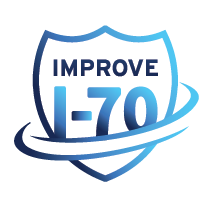Why Improve I-70?
I-70 is more than a frequently traveled local highway. It's also a critical state and regional corridor and a nationally important interstate. Improve I-70 efforts will help MoDOT ensure that the interstate continues to serve as a safe, efficient, environmentally sound and cost-effective facility for those traveling within the state, as well as those traveling through it.
Improve I-70 because…
- Traffic Safety - The number and severity of traffic-related accidents along I-70 between Kansas City and St. Louis has grown and will continue to grow with projected increases in travel.
- Roadway Capacity - Today, congestion makes portions of I-70 a stop-and-go driving experience. Without action, future I-70 travelers will experience deteriorating conditions throughout the corridor, including significantly reduced speeds, congestion, and excessive traffic volumes.
- System Preservation - The newest stretch of I-70 is 37 years old. The oldest stretch is 46 years old. The original design life of the interstate was 20 years. Both pavement and bridges will need major maintenance and rehabilitation over the next 30 years.
- Roadway Design Features - Designed in 1956, many features of I-70 are not in sync with today's safer, more efficient design standards. Improving the design of I-70 will enhance its safety and efficiency and provide a higher return on MoDOT's investment.
- Move Goods More Efficiently - Freight traffic is important to the state and the national economy - and I-70 is an especially important freight corridor. As truck traffic grows, operations on I-70 will continue to degrade at an ever increasing rate.
- Access to Recreational Facilities - Tourism is a $7.8 billion per year industry in Missouri, employing nearly 191,000 Missourians and generating hundreds of millions in state and local taxes. I-70 is the largest gateway to the vast amount of tourist and recreational destinations in the state.
What is the Cost?
Widening and reconstructing the 199-miles of I-70 between Kansas City and St. Louis is expected to cost about $3 billion. No funding has been allocated for steps beyond the Improve I-70 Studies.
The Studies are part of MoDOT's long range transportation planning efforts. Their completion will ensure that immediate needs on I-70 are addressed within the context of a long-range view for the corridor. This approach will ultimately save taxpayer dollars by working from a single, comprehensive plan for I-70 improvements.
Why this Strategy
Each of the corridor-wide improvement strategies considered during the First Tier Study of I-70 had some benefit. However, the widening and reconstruction strategy presents the best balance for achieving future goals. This strategy will:
- Meet the long-term travel and safety needs for the corridor
- Respond to public concerns
- (widening favored over other options by two-to-one)>Preserve the system by replacing existing I-70 pavement
- Lower annual operations and maintenance costs
- Reinvest in the existing system
- Be built in usable increments, yielding earlier benefits
- Incorporate high-tech improvements
- (weigh-in-motion for freight carriers, highway advisory radio, remote weather sensors, variable message signs)
- Improve incident management
"We looked very carefully at each of the strategies. We evaluated each strategy on how well it met the needs of the corridor. We looked at the impacts to the natural and the social environments and we considered the input of the public. We focused on the widening strategy because it was a sound engineering and environmental approach and because the public overwhelmingly favored it by a two-to-one margin." - Kathy Harvey
Additionally, this strategy will allow MoDOT to construct improvements while maintaining four lanes of traffic at all times. This alone is a tremendous benefit to the traveling public, considering the many years it will take to complete I-70 improvements. The widening and reconstruction strategy will safely accommodate cars and trucks, allow for future options in the median and provide superior management of traffic during accidents.
What are the Benefits?
Today, I-70 is a four-lane corridor across much of the state. Its narrow shoulders, narrow median and poor pavement conditions make traveling I-70 an uncomfortable and challenging experience. This situation is likely to worsen with increasing demand in the years ahead.
The widening and reconstruction strategy will provide the following benefits to motorists traveling I-70:
Enhanced Safety
- Wider shoulders and median to provide safe zones for travelers
- Upgraded interchanges, bridges, roadway alignment and roadway cross-sections that meet today's standards
- Develop a long-range plan for continuous frontage roads on both sides for better incident management
Greater Capacity
- Expanded right of way, typically by 150 feet
- Six lanes in rural areas (roughly 80 percent of corridor)
- Up to ten lanes in urban areas where warranted (roughly 20 percent of corridor)
- Future transportation improvement corridor in the median of rural areas
Other Benefits
- Four lanes operational during construction
- Improved interchanges with enhanced access management
- A corridor plan for environmental enhancements
- Smoother, safer and stronger pavement

